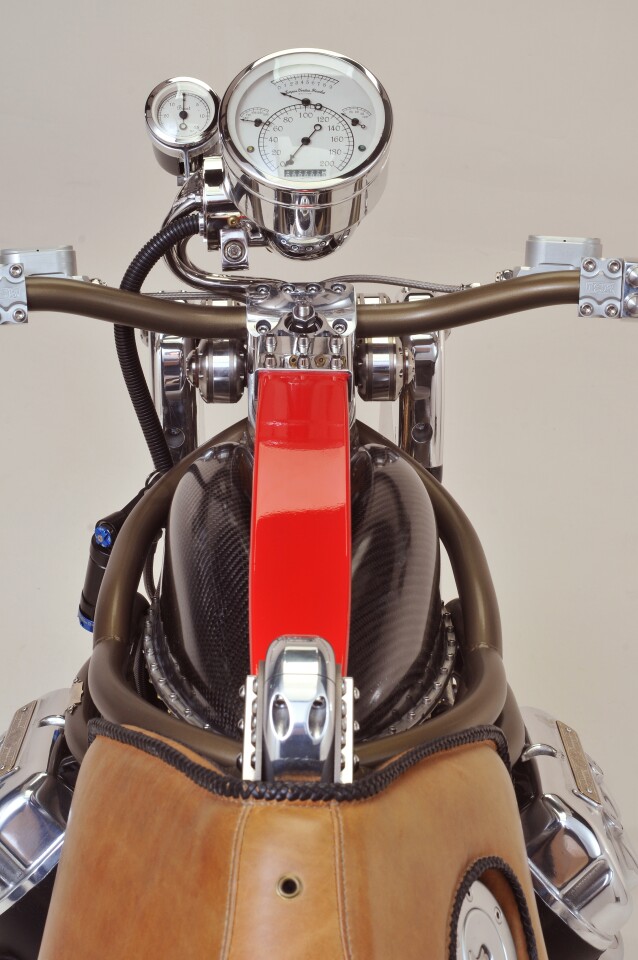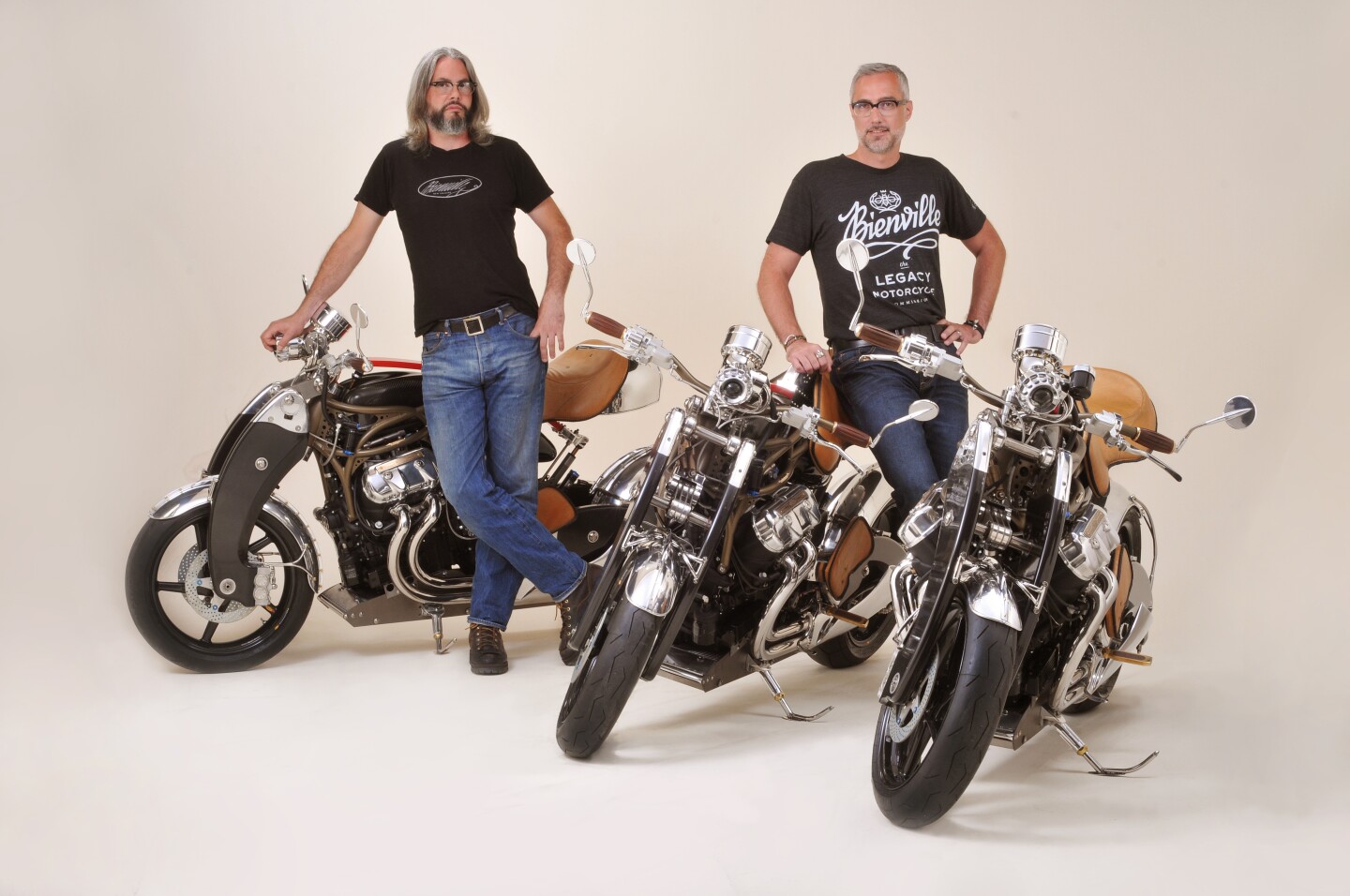On face value, the Bienville Legacy is a weird, vastly overpowered and visually shocking motorbike with a completely unique suspension system. But to the team that created it and the eccentric entrepreneur that bankrolled it, it's not just a motorcycle. It's a two-wheeled expression of blue-sky design, the realization of an idea unhindered by commercial realities – and the start of a movement that aims to celebrate and re-invigorate the idea of master craftsmanship in America.
What would you design, if time and money were no object? It's the sort of question that sorts out the men from the boys, the ambitious from the adequate. It represents the ultimate opportunity for some, and shines a harsh light on the mediocrity of others. If anyone ever asked me that question, I'd straight up soil my pants.
J.T. Nesbitt is not the pants-soiling type. A master designer already responsible for some of the most outrageous motorcycle shapes ever made, Nesbitt was asked the question by a man with the wherewithal to make things happen, and he had a killer answer ready.
Entrepreneur Jim Jacoby had just sold his company and was sitting on a pile of cash and a dream: to revitalize the concept of master craftsmanship in American design. Fed up with cheap consumerism, commercially driven design and planned obsolescence, he yearned to build things of true quality in the "Zen and the Art of Motorcycle Maintenance" sense. Things that were not disposable. Things that could turn the world upside down. Things that were driven purely by design, with no regard for price or commercial viability. He founded an organization he called the American Design and Master Craft Initiative (ADMCi) and went looking for a flagship project to kick off with.

J.T. Nesbitt caught Jacoby's eye with his jaw-dropping work at Confederate Motorcycles, where he designed the gleaming metallic Wraith. The Wraith simply didn't look like other motorcycles. It looked industrial and brutal, with a curved tube spine, a tiny saddle, a chunky fuselage-style underbelly and a wicked carbon girder front suspension system. Each individual part of the bike looked like it was built to last a thousand years. In Jacoby's eye, it was the perfect motorcycle, and Nesbitt was the perfect master craftsman to start his mission with.
As chance had it, Hurricane Katrina had wiped out Confederate's factory in New Orleans. The Confederate team had moved to Alabama, Nesbitt hadn't gone with them, and now instead of designing game-changing motorcycles for a living, he was working as a barman and continuing to design in his own time.
The pair met, Jacoby asked the question, and Nesbitt had a quick response ready, complete with sketches and notes. He wanted to improve upon the Wraith – blow it out of the water, no less – and in the process build the fastest American motorcycle ever made.
An arrangement was made whereby Jacoby gave Nesbitt the freedom and resources to design and build three commissioned pieces for the ADMCi, which would also take on ownership of patents produced during the production to sustain the next project and beyond. And with that, the Bienville Legacy was born.

The Legacy starts out with a 1650cc Motus MV4 engine. The sideways V4 makes around 185 horsepower in stock form, but Nesbitt has added a Rotrex centrifugal supercharger to take the total power well over 300 horses.
Building out from there, things start to get a little freaky; the frame is designed around a giant composite polymer leaf spring – think of an archer's bow, pointed toward the sky. That spring joins both the swingarm and the girder forks to the frame. This single giant spring suspends both ends of the bike. Each end has its own damping unit, a mountain bike component designed to handle huge downhill jump landings. It provides progressively harder damping as it compresses, making it virtually impossible to bottom out.

The girder front-end and rear swingarm feature nearly-identical carbon composite blades with eccentric adjusters built in. The adjusters allow for a change of trail at the front, and serve as chain adjusters at the rear, and are adjustable via a small worm gear. Similar adjusters let you change the seat height, the rear ride height and the headlight angle.
A chromoly trellis frame anchors the engine to the middle of the leaf spring, and supports a minimalistic seat unit. It should be noted that the Legacy's leather saddle hides a massively over-engineered support structure consisting of six titanium blades, which echo the curve of the leaf spring, the suspension blades and the upswept exhaust cans.

The whole thing has been designed by hand, with sketches being translated to CAD designs for machining. Just about the whole bike, down to its titanium bolts, comes from those sketches. As you can imagine, that's not a cheap way to build.
For a step forward in motorcycle design, it sure has a kind of backward look to it, almost as if the Wraith was built in some alternate steampunk-era universe.

As an ADMCi commission, it's not destined for scale production. Instead, just three have been built, and once the team has successfully set three land speed records they've got their eye on at Bonneville, the Bienville project will end.
The bikes will be available to serious collectors for around a quarter of a million US dollars apiece, but it won't be a straight sale, more like a stewardship. The buyers will be expected to exhibit the bikes all around America, as ambassadors of fine mechanical craftsmanship and elite design, and Jacoby will find another master designer and craftsperson in a completely different field to start another project with.

Whether or not the Bienville Legacy resonates with you as a finished motorcycle – and like the Wraith, there will be as many detractors as there are fans – the concept of master craftsmanship, unfettered by the commercial reality most designers live under, is an interesting one.
Another school of thought would say that restrictions inspire creative solutions, and that projects like the Legacy are purely masturbatory if they don't result in practical, affordable products that change people's lives.
Personally I'm glad that somebody with ideas as wild as J.T. Nesbitt was given the opportunity to bring vision to reality, and I'm really looking forward to seeing what Jim Jacoby and the ADMCi produce next time somebody has a great answer to that terrifying question: What would you design, if time and money were no object?
Sources: Bienville Legacy / American Design and Master Craft Institute. There's also a great article at odd-bike.com.






















